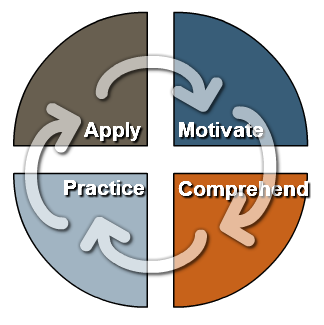Refreshing the Learning Cycle
When you are teaching a class, what is the first thing you do? Do you explain a concept? Do you describe a process or a skill?
Ideally, you motivate them. You inspire learners to know why they want to learn. For each of your highly motivated learners, you might have two or three who are in your class to fill a requirement and just get by. If you can give learners the motivation to be engaged and participate, you’ll have a more interesting class to teach, and learners will be more likely to transfer what they’ve learned in your class to real life situations.
When you design a learning plan, a motivating activity as a first step helps to set the pace. After that the learning cycle moves into comprehension, practice and application.
- Motivation
At the motivation stage you facilitate the attention process by inspiring learners to learn and answering the question, “Why do I want to learn this information or skill?”
- Comprehension
During the comprehension stage you facilitate encoding and processing in the working memory by clarifying performance expectations and helping learners access the information they need to perform the target competency.
- Practice
In the practice stage you need to provide guided practice—elaborative rehearsal, giving feedback to facilitate encoding to long-term memory.
- Application
Finally, at the application stage, foster retrieval from the long-term memory to enable working memory processing on demand. During the application stage learners need to show that they can apply what they have learned to real world problems and decision-making. It is during the application stage that you build in assessment.
Back and Forth
We call it a cycle, but learning cycle can also brake and move in the opposite direction. Consider the comprehension and practice phases of the cycle. Learners often need to move back and forth between the comprehension and practice stages before moving on to application. When your learning plan supports this back and forth, you help learners avoid cognitive overload by chunking the learning into manageable pieces. Learners who wear down a path between comprehension and practice are moving toward achieving the course outcomes.
Read more: WIDS Helps You Ask Why
1914